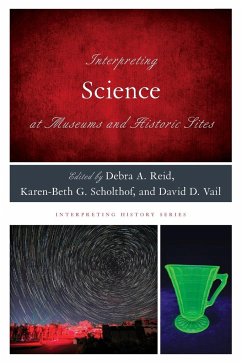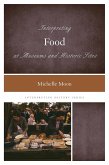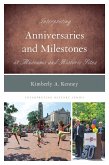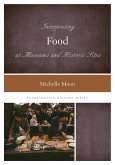Interpreting Science at Museums and Historic Sites
Herausgeber: Reid, Debra A.; Vail, David D.; Scholthof, Karen-Beth G.
Interpreting Science at Museums and Historic Sites
Herausgeber: Reid, Debra A.; Vail, David D.; Scholthof, Karen-Beth G.
- Gebundenes Buch
- Merkliste
- Auf die Merkliste
- Bewerten Bewerten
- Teilen
- Produkt teilen
- Produkterinnerung
- Produkterinnerung
Interpreting Science in Museums and Historic Sites stresses the untapped potential of historical artifacts to inform our understanding of scientific topics. It argues that science gains ground when contextualized in museums and historic sites.
Andere Kunden interessierten sich auch für
![Interpreting American Jewish History at Museums and Historic Sites Interpreting American Jewish History at Museums and Historic Sites]() Avi Y. DecterInterpreting American Jewish History at Museums and Historic Sites59,99 €
Avi Y. DecterInterpreting American Jewish History at Museums and Historic Sites59,99 €![Interpreting Food at Museums and Historic Sites Interpreting Food at Museums and Historic Sites]() Michelle MoonInterpreting Food at Museums and Historic Sites116,99 €
Michelle MoonInterpreting Food at Museums and Historic Sites116,99 €![Interpreting Naval History at Museums and Historic Sites Interpreting Naval History at Museums and Historic Sites]() Benjamin J. HruskaInterpreting Naval History at Museums and Historic Sites51,99 €
Benjamin J. HruskaInterpreting Naval History at Museums and Historic Sites51,99 €![Interpreting American Military History at Museums and Historic Sites Interpreting American Military History at Museums and Historic Sites]() Marc K. BlackburnInterpreting American Military History at Museums and Historic Sites123,99 €
Marc K. BlackburnInterpreting American Military History at Museums and Historic Sites123,99 €![Interpreting Anniversaries and Milestones at Museums and Historic Sites Interpreting Anniversaries and Milestones at Museums and Historic Sites]() Kimberly A. KenneyInterpreting Anniversaries and Milestones at Museums and Historic Sites116,99 €
Kimberly A. KenneyInterpreting Anniversaries and Milestones at Museums and Historic Sites116,99 €![Interpreting American Jewish History at Museums and Historic Sites Interpreting American Jewish History at Museums and Historic Sites]() Avi Y. DecterInterpreting American Jewish History at Museums and Historic Sites124,99 €
Avi Y. DecterInterpreting American Jewish History at Museums and Historic Sites124,99 €![Interpreting Food at Museums and Historic Sites Interpreting Food at Museums and Historic Sites]() Michelle MoonInterpreting Food at Museums and Historic Sites59,99 €
Michelle MoonInterpreting Food at Museums and Historic Sites59,99 €-
-
-
Interpreting Science in Museums and Historic Sites stresses the untapped potential of historical artifacts to inform our understanding of scientific topics. It argues that science gains ground when contextualized in museums and historic sites.
Hinweis: Dieser Artikel kann nur an eine deutsche Lieferadresse ausgeliefert werden.
Hinweis: Dieser Artikel kann nur an eine deutsche Lieferadresse ausgeliefert werden.
Produktdetails
- Produktdetails
- Interpreting History
- Verlag: Globe Pequot Publishing Group Inc/Bloomsbury
- Seitenzahl: 266
- Erscheinungstermin: 11. September 2023
- Englisch
- Abmessung: 260mm x 183mm x 19mm
- Gewicht: 701g
- ISBN-13: 9781538172742
- ISBN-10: 1538172747
- Artikelnr.: 67786411
- Herstellerkennzeichnung
- Books on Demand GmbH
- In de Tarpen 42
- 22848 Norderstedt
- info@bod.de
- 040 53433511
- Interpreting History
- Verlag: Globe Pequot Publishing Group Inc/Bloomsbury
- Seitenzahl: 266
- Erscheinungstermin: 11. September 2023
- Englisch
- Abmessung: 260mm x 183mm x 19mm
- Gewicht: 701g
- ISBN-13: 9781538172742
- ISBN-10: 1538172747
- Artikelnr.: 67786411
- Herstellerkennzeichnung
- Books on Demand GmbH
- In de Tarpen 42
- 22848 Norderstedt
- info@bod.de
- 040 53433511
Debra A. Reid, PhD, is curator of agriculture and the environment at The Henry Ford (THF). She has experience with AASLH's "Interpreting History" series, as author of Interpreting Agriculture at Museums and Historic Sites (2017) and co-author with David D. Vail of Interpreting the Environment at Museums and Historic Sites (2019). She is a fellow of the Agricultural History Society, and has received numerous additional awards for her teaching, research, and service. Her books include Reaping a Greater Harvest: African Americans, Rural Reform and the Texas Extension Service (2007), Beyond Forty Acres and a Mule: African American Landowning Families since Reconstruction (co-edited with Evan P. Bennett, 2012), and essays in anthologies including Companion to U.S. Agricultural History (forthcoming 2022), Science as Service: Establishing and Reformulating American Land-Grant Universities, 1865-1930 (2015), the Routledge History of Rural America (2016), and Arkansas Women: Their Lives and Times (2018). Karen-Beth G. Scholthof, PhD, is professor of plant pathology and microbiology at Texas A&M University. She earned her undergraduate B.S. in Botany (and a minor in philosophy) at Montana State University, an M.S. in plant pathology (virology) from the University of Nebraska-Lincoln, and a PhD in plant pathology (virology) at the University of Kentucky. Her course "Pathogens, the Environment and Society" reflects her keen interest in bringing plant pathology, public health, environmental sciences and the humanities to students in science majors. She has published more than 100 peer-reviewed manuscripts and book chapters on molecular plant virology and host-virus interactions. She is an elected fellow of the American Phytopathological Society, the American Society for Microbiology and the American Association for the Advancement of Science. David D. Vail, PhD, has training in environmental history, science and technology, earning a PhD at Kansas State University. He is associate professor in the Department of History at the University of Nebraska at Kearney. Vail has worked with universities and humanities councils to spread the word about the intersection of policy, science, and agricultural production. He serves as book reviews editor for The Public Historian (National Council on Public History), conference selection committee for the American Society for Environmental History, and the editorial committee of Agricultural History. His award-winning book, Chemical Lands: Pesticides, Aerial Spraying, and Health in North America's Grasslands since 1945 (2018), is part of the University of Alabama Press' NEXUS Series: New Histories of Science, Technology, the Environment, Agriculture, and Medicine.
Contents
Foreword
Jill Tiefenthaler, Chief Executive Officer, National Geographic Society
Preface by Karen-Beth G. Scholthof
Acknowledgments
Part I - Science, the Public Historian and Museum Collections
Introduction
Chapter 1: Communicating Climate Change with Archives of Nature and
Archives of
Societies by Sam White
Chapter 2: Creating Public Space for Complex Conversations by Melanie
Armstrong
Chapter 3: (Re)constructing the Past: Research and Science Interpretation
in Experimental
Archeological Open-Air Museums by Claus Kropp
Chapter 4: Local Weather, Distant Connections: Interpreting Meteorological
Instruments and Data by Roger Turner
Chapter 5: Medical Science Archives: Closer and More Accessible Than They
Might
Appear by April White and David D. Vail
Part II - Science and the Human Experience
Introduction
Chapter 6: From Farm to Table: A One-Health Scenario by Karen-Beth G.
Scholthof
Chapter 7: Seeing the Museum in the Garden: Using Living History Museums to
Teach the History of Plant Introductions by Emily Pawley
Chapter 8: The Outdoor Life: Seeking the "Cure" in New Mexico by Karen-Beth
G.
Scholthof
Chapter 9: "...In the Interest of the Health Conservation of the American
Negro":
National Negro Health Week, 1915-1951 by Cherisse Jones-Branch
Chapter 10: Irrigation History: Moving Water from Colorado Mountain Peaks
to
Fruited Plain by Patricia Rettig
Chapter 11: Exporting the "Wonders of Modern Science": Thinking
Scientifically
About Food Aid and Foreign Policy by Kristin Ahlberg
Part III - Science: A Culture of Doubt? A Culture of Questioning
Introduction
Chapter 12: Reflecting on Uncomfortable Science by Aimee Slaughter
Chapter 13: For Our Own Protection: On Black Gay Males and HIV/AIDS
Activism by
Jajuan S. Johnson
Chapter 14: Becoming a Scientist: Untangling the Roles of Chemistry Sets
by Debra A. Reid
Chapter 15: The "Gene Gun" and Genetic Engineering: Unpacking the Science
by Karen-
Beth G. Scholthof and Debra A. Reid
Chapter 16: Know your analyst, know your food? by Benjamin R. Cohen
Chapter 17: Science and Progress in the Kitchen: Forks, Eggbeaters, and
Sporks by
Karen-Beth G. Scholthof and Debra A. Reid
Part IV - Science and History Museum Education
Introduction
Chapter 18: Integrating Art and Science to Effectively Share Knowledge by
Bethann
Garramon Merkle
Chapter 19: School Gardens and Edible Education by Debra A. Reid
Chapter 20: A Yearbook of Science for the Public Good by David D. Vail
Chapter 21: Interpreting Scientists: An Interview with Storyteller Brian
"Fox" Ellis
Chapter 22: Design, Science, and Driven to Win: A History Museum Addresses
the
Innovation Opportunity Gap by Robert Oleary and Matt Anderson
Chapter 23: Exploring Science with Young Naturalists by Debra A. Reid
Conclusion
IDEAS: Inclusion, Diversity, Equity and Access to Science by Karen-Beth G.
Scholthof
Selected Readings
Timeline
Contributors
Index
Foreword
Jill Tiefenthaler, Chief Executive Officer, National Geographic Society
Preface by Karen-Beth G. Scholthof
Acknowledgments
Part I - Science, the Public Historian and Museum Collections
Introduction
Chapter 1: Communicating Climate Change with Archives of Nature and
Archives of
Societies by Sam White
Chapter 2: Creating Public Space for Complex Conversations by Melanie
Armstrong
Chapter 3: (Re)constructing the Past: Research and Science Interpretation
in Experimental
Archeological Open-Air Museums by Claus Kropp
Chapter 4: Local Weather, Distant Connections: Interpreting Meteorological
Instruments and Data by Roger Turner
Chapter 5: Medical Science Archives: Closer and More Accessible Than They
Might
Appear by April White and David D. Vail
Part II - Science and the Human Experience
Introduction
Chapter 6: From Farm to Table: A One-Health Scenario by Karen-Beth G.
Scholthof
Chapter 7: Seeing the Museum in the Garden: Using Living History Museums to
Teach the History of Plant Introductions by Emily Pawley
Chapter 8: The Outdoor Life: Seeking the "Cure" in New Mexico by Karen-Beth
G.
Scholthof
Chapter 9: "...In the Interest of the Health Conservation of the American
Negro":
National Negro Health Week, 1915-1951 by Cherisse Jones-Branch
Chapter 10: Irrigation History: Moving Water from Colorado Mountain Peaks
to
Fruited Plain by Patricia Rettig
Chapter 11: Exporting the "Wonders of Modern Science": Thinking
Scientifically
About Food Aid and Foreign Policy by Kristin Ahlberg
Part III - Science: A Culture of Doubt? A Culture of Questioning
Introduction
Chapter 12: Reflecting on Uncomfortable Science by Aimee Slaughter
Chapter 13: For Our Own Protection: On Black Gay Males and HIV/AIDS
Activism by
Jajuan S. Johnson
Chapter 14: Becoming a Scientist: Untangling the Roles of Chemistry Sets
by Debra A. Reid
Chapter 15: The "Gene Gun" and Genetic Engineering: Unpacking the Science
by Karen-
Beth G. Scholthof and Debra A. Reid
Chapter 16: Know your analyst, know your food? by Benjamin R. Cohen
Chapter 17: Science and Progress in the Kitchen: Forks, Eggbeaters, and
Sporks by
Karen-Beth G. Scholthof and Debra A. Reid
Part IV - Science and History Museum Education
Introduction
Chapter 18: Integrating Art and Science to Effectively Share Knowledge by
Bethann
Garramon Merkle
Chapter 19: School Gardens and Edible Education by Debra A. Reid
Chapter 20: A Yearbook of Science for the Public Good by David D. Vail
Chapter 21: Interpreting Scientists: An Interview with Storyteller Brian
"Fox" Ellis
Chapter 22: Design, Science, and Driven to Win: A History Museum Addresses
the
Innovation Opportunity Gap by Robert Oleary and Matt Anderson
Chapter 23: Exploring Science with Young Naturalists by Debra A. Reid
Conclusion
IDEAS: Inclusion, Diversity, Equity and Access to Science by Karen-Beth G.
Scholthof
Selected Readings
Timeline
Contributors
Index
Contents
Foreword
Jill Tiefenthaler, Chief Executive Officer, National Geographic Society
Preface by Karen-Beth G. Scholthof
Acknowledgments
Part I - Science, the Public Historian and Museum Collections
Introduction
Chapter 1: Communicating Climate Change with Archives of Nature and
Archives of
Societies by Sam White
Chapter 2: Creating Public Space for Complex Conversations by Melanie
Armstrong
Chapter 3: (Re)constructing the Past: Research and Science Interpretation
in Experimental
Archeological Open-Air Museums by Claus Kropp
Chapter 4: Local Weather, Distant Connections: Interpreting Meteorological
Instruments and Data by Roger Turner
Chapter 5: Medical Science Archives: Closer and More Accessible Than They
Might
Appear by April White and David D. Vail
Part II - Science and the Human Experience
Introduction
Chapter 6: From Farm to Table: A One-Health Scenario by Karen-Beth G.
Scholthof
Chapter 7: Seeing the Museum in the Garden: Using Living History Museums to
Teach the History of Plant Introductions by Emily Pawley
Chapter 8: The Outdoor Life: Seeking the "Cure" in New Mexico by Karen-Beth
G.
Scholthof
Chapter 9: "...In the Interest of the Health Conservation of the American
Negro":
National Negro Health Week, 1915-1951 by Cherisse Jones-Branch
Chapter 10: Irrigation History: Moving Water from Colorado Mountain Peaks
to
Fruited Plain by Patricia Rettig
Chapter 11: Exporting the "Wonders of Modern Science": Thinking
Scientifically
About Food Aid and Foreign Policy by Kristin Ahlberg
Part III - Science: A Culture of Doubt? A Culture of Questioning
Introduction
Chapter 12: Reflecting on Uncomfortable Science by Aimee Slaughter
Chapter 13: For Our Own Protection: On Black Gay Males and HIV/AIDS
Activism by
Jajuan S. Johnson
Chapter 14: Becoming a Scientist: Untangling the Roles of Chemistry Sets
by Debra A. Reid
Chapter 15: The "Gene Gun" and Genetic Engineering: Unpacking the Science
by Karen-
Beth G. Scholthof and Debra A. Reid
Chapter 16: Know your analyst, know your food? by Benjamin R. Cohen
Chapter 17: Science and Progress in the Kitchen: Forks, Eggbeaters, and
Sporks by
Karen-Beth G. Scholthof and Debra A. Reid
Part IV - Science and History Museum Education
Introduction
Chapter 18: Integrating Art and Science to Effectively Share Knowledge by
Bethann
Garramon Merkle
Chapter 19: School Gardens and Edible Education by Debra A. Reid
Chapter 20: A Yearbook of Science for the Public Good by David D. Vail
Chapter 21: Interpreting Scientists: An Interview with Storyteller Brian
"Fox" Ellis
Chapter 22: Design, Science, and Driven to Win: A History Museum Addresses
the
Innovation Opportunity Gap by Robert Oleary and Matt Anderson
Chapter 23: Exploring Science with Young Naturalists by Debra A. Reid
Conclusion
IDEAS: Inclusion, Diversity, Equity and Access to Science by Karen-Beth G.
Scholthof
Selected Readings
Timeline
Contributors
Index
Foreword
Jill Tiefenthaler, Chief Executive Officer, National Geographic Society
Preface by Karen-Beth G. Scholthof
Acknowledgments
Part I - Science, the Public Historian and Museum Collections
Introduction
Chapter 1: Communicating Climate Change with Archives of Nature and
Archives of
Societies by Sam White
Chapter 2: Creating Public Space for Complex Conversations by Melanie
Armstrong
Chapter 3: (Re)constructing the Past: Research and Science Interpretation
in Experimental
Archeological Open-Air Museums by Claus Kropp
Chapter 4: Local Weather, Distant Connections: Interpreting Meteorological
Instruments and Data by Roger Turner
Chapter 5: Medical Science Archives: Closer and More Accessible Than They
Might
Appear by April White and David D. Vail
Part II - Science and the Human Experience
Introduction
Chapter 6: From Farm to Table: A One-Health Scenario by Karen-Beth G.
Scholthof
Chapter 7: Seeing the Museum in the Garden: Using Living History Museums to
Teach the History of Plant Introductions by Emily Pawley
Chapter 8: The Outdoor Life: Seeking the "Cure" in New Mexico by Karen-Beth
G.
Scholthof
Chapter 9: "...In the Interest of the Health Conservation of the American
Negro":
National Negro Health Week, 1915-1951 by Cherisse Jones-Branch
Chapter 10: Irrigation History: Moving Water from Colorado Mountain Peaks
to
Fruited Plain by Patricia Rettig
Chapter 11: Exporting the "Wonders of Modern Science": Thinking
Scientifically
About Food Aid and Foreign Policy by Kristin Ahlberg
Part III - Science: A Culture of Doubt? A Culture of Questioning
Introduction
Chapter 12: Reflecting on Uncomfortable Science by Aimee Slaughter
Chapter 13: For Our Own Protection: On Black Gay Males and HIV/AIDS
Activism by
Jajuan S. Johnson
Chapter 14: Becoming a Scientist: Untangling the Roles of Chemistry Sets
by Debra A. Reid
Chapter 15: The "Gene Gun" and Genetic Engineering: Unpacking the Science
by Karen-
Beth G. Scholthof and Debra A. Reid
Chapter 16: Know your analyst, know your food? by Benjamin R. Cohen
Chapter 17: Science and Progress in the Kitchen: Forks, Eggbeaters, and
Sporks by
Karen-Beth G. Scholthof and Debra A. Reid
Part IV - Science and History Museum Education
Introduction
Chapter 18: Integrating Art and Science to Effectively Share Knowledge by
Bethann
Garramon Merkle
Chapter 19: School Gardens and Edible Education by Debra A. Reid
Chapter 20: A Yearbook of Science for the Public Good by David D. Vail
Chapter 21: Interpreting Scientists: An Interview with Storyteller Brian
"Fox" Ellis
Chapter 22: Design, Science, and Driven to Win: A History Museum Addresses
the
Innovation Opportunity Gap by Robert Oleary and Matt Anderson
Chapter 23: Exploring Science with Young Naturalists by Debra A. Reid
Conclusion
IDEAS: Inclusion, Diversity, Equity and Access to Science by Karen-Beth G.
Scholthof
Selected Readings
Timeline
Contributors
Index








